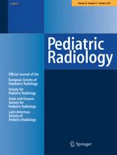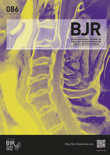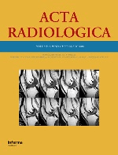
EUROPEAN JOURNAL OF RADIOLOGY
Scope & Guideline
Transforming Patient Care Through Radiological Research
Introduction
Aims and Scopes
- Clinical Imaging Techniques:
Research related to various imaging modalities including MRI, CT, ultrasound, and PET, focusing on their diagnostic and therapeutic applications in different medical conditions. - Artificial Intelligence in Radiology:
Exploration of AI and machine learning applications in image analysis, diagnosis, and radiology workflow optimization. - Radiomics and Biomarkers:
Studies that utilize radiomics to extract quantitative features from medical images for prognostic and predictive modeling in various cancers and diseases. - Interventional Radiology Techniques:
Innovations and outcomes related to minimally invasive procedures guided by imaging techniques, including ablation therapies and biopsies. - Patient Safety and Quality Assurance:
Research addressing the safety aspects of imaging procedures, radiation dose management, and quality control in radiological practices. - Multimodal Imaging Approaches:
Integration of different imaging modalities to enhance diagnostic accuracy and treatment planning, particularly in oncology and complex medical cases.
Trending and Emerging
- Deep Learning and AI Applications:
An increasing number of studies are focusing on the application of deep learning algorithms and AI in radiology, enhancing diagnostic accuracy and workflow efficiency. - Quantitative Imaging Biomarkers:
There is a growing emphasis on the development and validation of quantitative imaging biomarkers that can predict treatment response and patient outcomes, particularly in oncology. - Integration of Imaging and Genomics:
Research that combines imaging data with genomic information to provide a more comprehensive understanding of diseases is gaining traction, promoting personalized medicine. - Telemedicine and Remote Imaging:
The rise of telemedicine and remote imaging solutions has led to an increase in studies exploring their effectiveness, particularly in the context of the COVID-19 pandemic. - Patient-Centric Imaging Approaches:
Emerging research is focusing on patient experiences and outcomes related to imaging procedures, emphasizing the importance of patient-centered care in radiology. - Advanced Imaging Techniques in Oncology:
Innovations in imaging techniques that enhance the detection and characterization of tumors, including hybrid imaging modalities and novel contrast agents, are increasingly featured.
Declining or Waning
- Traditional Radiology Techniques:
There is a noticeable decline in studies focusing solely on traditional imaging techniques without the integration of advanced technologies or AI, as the field moves toward more innovative and efficient methods. - Basic Imaging Studies:
The journal has seen fewer publications regarding basic imaging studies that do not involve complex analysis or novel methodologies, indicating a shift towards more applied and impactful research. - Non-Quantitative Imaging Research:
Research that does not employ quantitative methods or radiomics is becoming less frequent, as the emphasis on data-driven approaches and objective measurements in imaging grows. - Descriptive Studies Without Clinical Implications:
There is a reduction in publications that primarily describe imaging findings without linking them to clinical outcomes or actionable insights, reflecting a trend towards more clinically relevant research.
Similar Journals

PEDIATRIC RADIOLOGY
Empowering clinicians through cutting-edge research.Pediatric Radiology is a leading journal published by Springer that provides a crucial platform for the dissemination of research in the fields of pediatrics, perinatology, and radiology. Since its inception in 1973, the journal has continually contributed to the advancement of medical imaging techniques and their application in diagnosing and treating pediatric conditions. With its impact factor reflecting a Q2 ranking in both Pediatrics and Radiology categories as of 2023, Pediatric Radiology is highly regarded in scholarly circles, aiding researchers, clinicians, and students to stay at the forefront of innovations and findings in the field. Although the journal does not offer open access, it continues to be an essential resource for evidence-based information that enhances clinical practice and improves health outcomes for children globally. The journal's reach is further established through its solid Scopus rankings, indicating its relevance and influence in the global medical community.

Tomography
Transforming the landscape of medical imaging and diagnostics.Tomography is an esteemed peer-reviewed journal published by MDPI, focusing on a broad spectrum of topics related to medical imaging and diagnostics. Launched in 2015, this Open Access journal serves as a vital platform for researchers, professionals, and students in the fields of medicine, radiology, nuclear medicine, and imaging. With an impressive impact factor reflecting its relevance, the journal has achieved a quartile ranking of Q2 in both Medicine (Miscellaneous) and Radiology, Nuclear Medicine, and Imaging as of 2023. Renowned for disseminating high-quality research, Tomography welcomes original research articles, reviews, and technical notes, fostering innovation and collaboration within the scientific community. Housed in Basel, Switzerland, the journal aims to bridge the gap between fundamental research and clinical application, appealing to a diverse readership eager to advance the field of medical imaging.

BRITISH JOURNAL OF RADIOLOGY
Advancing Radiology Through Innovation and ExcellenceBritish Journal of Radiology is a leading peer-reviewed journal published by the British Institute of Radiology, dedicated to advancing the field of radiology, nuclear medicine, and imaging. With a prestigious history dating back to 1945, this journal is at the forefront of disseminating cutting-edge research and innovations that significantly impact clinical practice. Currently enjoying a Q1 ranking in the field of radiology and Q2 in general medicine for 2023, it is recognized for its rigorous standards and high-quality content, ranking #87 out of 333 in Scopus for specialties related to Medicine, Radiology, Nuclear Medicine, and Imaging, placing it in the 74th percentile. Researchers, professionals, and students are encouraged to engage with the latest findings and comprehensive reviews presented within its pages, which contribute not only to academic discourse but also to the evolution of practice in the wider medical community.

ACTA RADIOLOGICA
Exploring the Frontiers of Radiological ScienceACTA RADIOLOGICA, published by SAGE Publications Ltd, is a premier journal dedicated to the evolving field of radiology, bridging the gap between clinical practice and research from its inception in 1921 to its anticipated continuation until 2024. With an ISSN of 0284-1851 and an E-ISSN of 1600-0455, this esteemed journal holds a significant position in the academic landscape, reflected in its 2023 rankings as Q3 in several categories, including Medicine (miscellaneous), Radiological and Ultrasound Technology, and Radiology, Nuclear Medicine and Imaging. Although currently not an open-access journal, ACTA RADIOLOGICA offers robust subscription options allowing a wide readership among researchers, healthcare professionals, and students striving to stay at the forefront of radiological advancements. The journal publishes original research, reviews, and clinical studies that contribute to the understanding and application of imaging technologies, underscoring its vital role in shaping modern medical practices.

European Radiology Experimental
Exploring New Frontiers in Radiological SciencesEuropean Radiology Experimental is a premier open-access journal published by Springer Wien, dedicated to advancing the field of radiology through innovative research and experimentation. Since its establishment in 2017, the journal has quickly gained recognition, evidenced by its impressive Q1 ranking in the Radiology, Nuclear Medicine and Imaging category, and its placement within the top 83rd percentile of the Scopus rankings. Based in the United Kingdom, this journal aims to bridge the gap between clinical practice and cutting-edge research, providing a platform for rigorous peer-reviewed articles that explore new methodologies, technologies, and insights in radiological sciences. With a commitment to open access, European Radiology Experimental ensures that its content is readily accessible to a global audience, supporting the dissemination of knowledge and fostering collaborations among researchers, professionals, and students in the medical imaging community. As it progresses through its convergence years, the journal continues to play a vital role in shaping the future of radiological research and practice.

EUROPEAN RADIOLOGY
Leading the Way in Radiological ExcellenceEUROPEAN RADIOLOGY, published by SPRINGER, stands as a prestigious international journal in the field of radiology, nuclear medicine, and imaging, with an impressive impact factor that underscores its significance among peers. With an ISSN of 0938-7994 and an E-ISSN of 1432-1084, this journal provides a platform for cutting-edge research and advancements in medical imaging from 1991 to 2024. Recognized as a Q1 journal in both general Medicine and the specialized Radiology category by 2023, EUROPEAN RADIOLOGY ranks an impressive #17 out of 333 in its field according to Scopus, placing it in the 95th percentile. While it does not currently offer Open Access options, the journal remains essential reading for researchers, professionals, and students striving to stay at the forefront of developments in diagnostic imaging and related technologies. By contributing to a comprehensive understanding of radiological practices, EUROPEAN RADIOLOGY plays a crucial role in shaping the future of medical diagnosis and patient care.

Egyptian Journal of Radiology and Nuclear Medicine
Advancing the Frontiers of Radiology and Nuclear MedicineThe Egyptian Journal of Radiology and Nuclear Medicine, published by Springer, is a premier open access journal that has provided valuable insights and advancements in the fields of radiology and nuclear medicine since its initiation in 2010. With an E-ISSN of 2090-4762, this journal is dedicated to bridging the gap between research and clinical practice, allowing for the dissemination of high-quality research to a global audience. Situated in Germany, it enjoys a robust reputation in the academic community, evidenced by its categorization in the Q3 quartile for 2023, as well as its Scopus ranking, where it holds a position of #225 out of 333 in the domain of Radiology, Nuclear Medicine and Imaging, placing it in the 32nd percentile. The journal's open access model ensures that researchers, professionals, and students can freely access innovative studies, reviews, and case reports that discuss the latest methodologies, technological advancements, and clinical outcomes in radiology and nuclear medicine. As it looks toward its converged years spanning from 2010 to 2024, the Egyptian Journal of Radiology and Nuclear Medicine continues to be an essential resource for advancing knowledge and fostering ongoing collaboration in these critical fields.

ROFO-FORTSCHRITTE AUF DEM GEBIET DER RONTGENSTRAHLEN UND DER BILDGEBENDEN VERFAHREN
Fostering Excellence in Radiological Research and PracticeROFO-Fortschritte auf dem Gebiet der Röntgenstrahlen und der bildgebenden Verfahren, published by Georg Thieme Verlag KG, is a pivotal journal in the fields of radiology and nuclear medicine, offering invaluable insights for researchers, healthcare professionals, and students alike. With an ISSN of 1438-9029, this journal has been a stalwart of scientific communication since its inception in 1975, actively contributing to advancements in imaging techniques and radiation therapy. Although it operates under traditional access, the journal maintains a respectable standing, reflected by its Q3 ranking in Radiology, Nuclear Medicine and Imaging and Q4 in Medicine (miscellaneous), highlighting its significance in the scholarly community. Its coverage spans a wide array of topics pertinent to diagnostic imaging and therapy protocols, making it an essential resource for anyone seeking to understand the complexities of modern radiological practices. As the journal continues to evolve through 2024, it invites contributions that enrich the dialogue around technological innovations and clinical applications in the realm of imaging modalities.

Radiological Physics and Technology
Innovating the future of radiation technology.Radiological Physics and Technology, published by SPRINGER JAPAN KK, is a prominent journal that serves as a crucial resource in the multidisciplinary fields of medicine and radiation sciences. With an ISSN of 1865-0333 and an E-ISSN of 1865-0341, the journal has been converging impactful research from 2008 to 2024. It holds a commendable position in academic rankings, currently classified in Q2 in Physical Therapy, Sports Therapy and Rehabilitation and Radiation, along with Q3 for Medicine (miscellaneous) and Radiology, Nuclear Medicine and Imaging. The journal is well-regarded in the academic community, reflected in its Scopus rankings that place it in the upper tiers of its respective categories. Although it currently does not offer Open Access, Radiological Physics and Technology remains a pivotal publication for researchers, academics, and practitioners seeking to advance knowledge and foster innovation in radiological science. Its commitment to disseminating high-quality research ensures its continued relevance and importance within these fields.

Insights into Imaging
Advancing the Frontiers of Medical ImagingInsights into Imaging is a prominent open-access journal published by SPRINGER WIEN, specializing in the dynamic fields of radiology, nuclear medicine, and imaging, with its ISSN 1869-4101. Established in 2012, the journal has established itself as a leading platform for disseminating high-quality research and innovative findings, currently holding a prestigious Q1 ranking in its category as of 2023. With an impressive Scopus rank of #42 out of 333 in the medicine discipline, the journal is positioned in the 87th percentile, reflecting its significance and influence in the academic community. Based in Germany, Insights into Imaging not only provides unrestricted access to research but also aims to bridge the gap between scientific inquiry and clinical application, making it an essential resource for researchers, professionals, and students engaged in advancing imaging technologies and practices. The journal’s commitment to fostering knowledge exchange ensures that it remains a critical contributor to the evolving landscape of medical imaging, with articles available from 2012 through 2024.